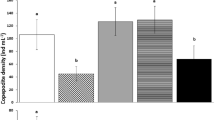Abstract
Aquatic oligochaetes may potentially become an important constituent in commercial aquaculture as a live food source. Tubifex tubifex, Limnodrilus species, Branchiura sowerbyi and the lumbriculid Lumbriculus variegatus have been economically mass cultured with production rates of 15 kg m- and population doubling times of 11–42 days reported. Relatively high growth and survival rates of trout, salmon and sturgeon have been achieved in association with the use of this live food source. Benefits stem from advantages with increased appetites and palatability. As well, sanitation and heating requirements in fish hatchery situations may be reduced. Disease transmission must be prevented.
Similar content being viewed by others
References
Aston, R. J., K. Sadler & A. G. P. Milner, 1982. The effects of temperature on the culture of Branchiura sowerbyi (Oligochaeta, Tubificidae) on activated sludge. Aquaculture 29: 137–145.
Buddington, R. K. & S. I. Doroshov, 1984. Feeding trials with hatchery produced white sturgeon (Acipenser transmontanus). Aquaculture 36: 237–243.
Fisher, J. A. & A. M. Beeton, 1975. The effects of dissolved oxygen on the burrowing behavior of Limnodrilus hoffmeisteri (Oligochaeta). Hydrobiologia 47(2): 273–290.
Hernandez, C., G. Rangel, C. Munoz & L. R. Tovar, 1984. Development of fish feed using Tubifex species as the raw material (Desarrollo de alimento para peces utilizando gusanos de fango como materia prima). Technol. Aliment. 19(1): 9.
Marian, M. P. & T. J. Pandian, 1984. Culture and harvesting techniques for Tubifex Tubifex. Aquaculture 42: 303–315.
Phillips, G. R. & D. R. Buhler, 1979. Influences of dieldrin on the growth and body composition of fingerling rainbow trout (Salmo gairdneri) fed Oregon Moist Pellets or Tubificid worms (Tubifex sp.). J. Fish. Res. Bd. Can. 36: 77–80.
Poddubnaya, T. L., 1979. Life cycles of mass species of Tubificidae (Oligochaeta). In R. O. Brinkhurst & D. G. Cook (eds.) Aquatic Oligochaete Biology. Plenum Press, NY.: 175–184.
Timm, T. E., 1972. Culture methods for aquatic oligochaeta. In G. M. Belyaev et al. (eds.) Vodnye malshchetinkovye chervi (sistematika, ekologiya, issledovaniya fauny S.S.S.R.) Trudy Vsesoyuzogo Gibrobiol. Obshch. Nauka Moscow. 17: 106–117.
Author information
Authors and Affiliations
Rights and permissions
About this article
Cite this article
Lietz, D.M. Potential for aquatic oligochaetes as live food in commercial aquaculture. Hydrobiologia 155, 309–310 (1987). https://doi.org/10.1007/BF00025665
Issue Date:
DOI: https://doi.org/10.1007/BF00025665




